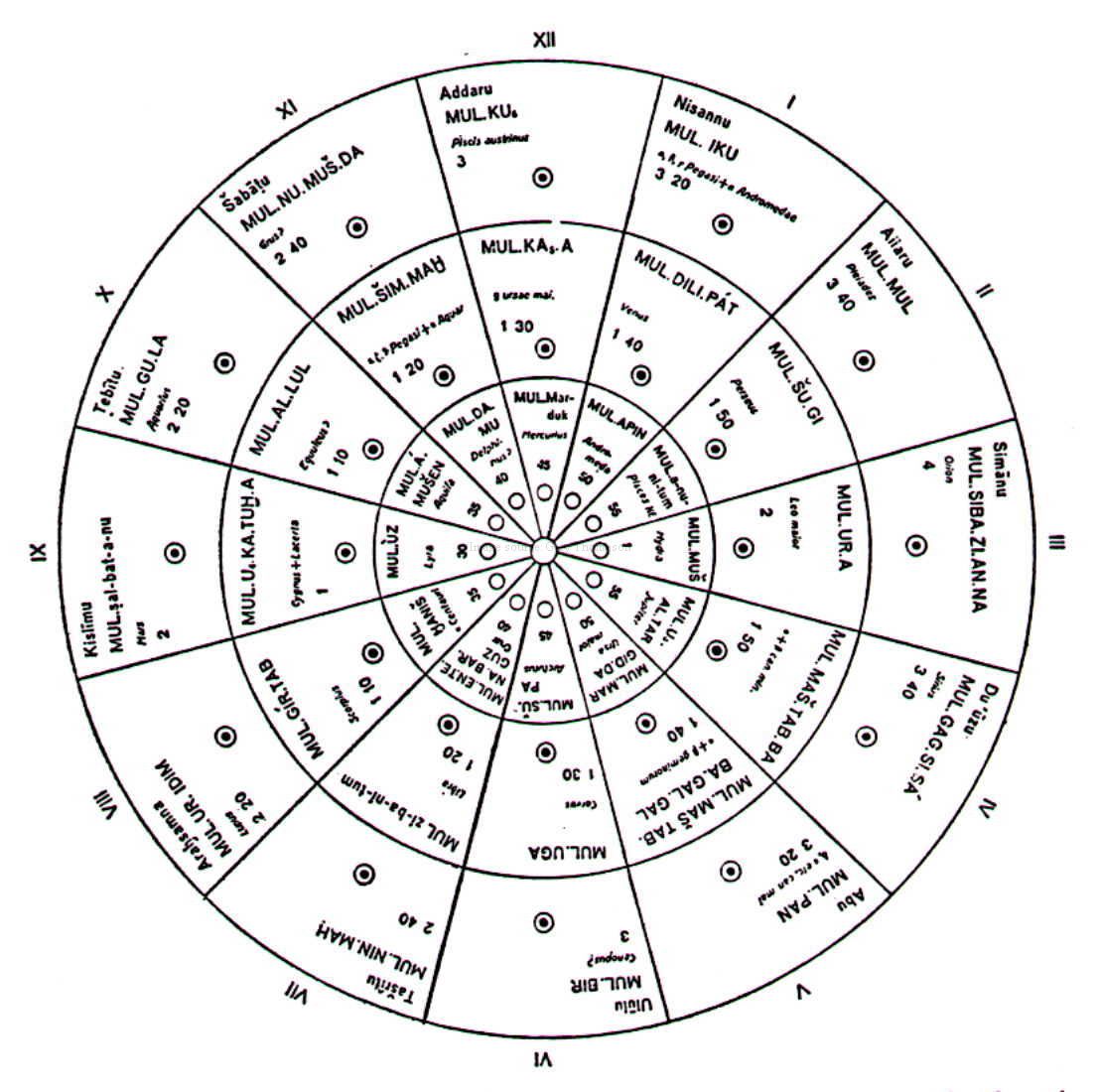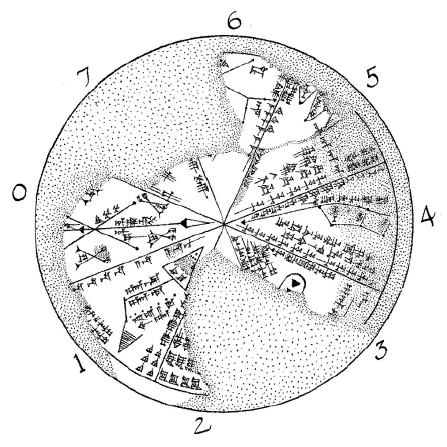Si j'en crois ce qu'écrit James Evans, la tablette circulaire K.8538 du British Museum ressemble à ce qu'on appelle un "astrolabe circulaire" remontant à Babylone:
https://www.britishmuseum.org/collection/object/W_K-8538?fbclid=IwAR3TZKWfMntN6OH1vOVky119YDTbfCXkB3NOiMsgZIW6yJ2boEdDDYFVtZ4
Le curateur du BM a écrit:Curator's comments
For comment on the interpretation of the text and identification of the constellations see Koch 1989. Celestial planisphere; in this stylised map the sky has been divided into eight sections. It represents the night sky of 3-4 January 650 BC over Nineveh. The rectangular shape at the top has been identified as the constellation known today as Gemini and the stars contained with an oval shape are the Pleiades. The two triangles in the lower right mark the bright stars of Pegasus.
Planisphère céleste ; sur cette carte stylisée, le ciel a été divisé en huit sections. Il représente le ciel nocturne des 3 et 4 janvier 650 av. J.-C. au-dessus de Ninive. La forme rectangulaire au sommet a été identifiée comme étant la constellation connue aujourd'hui sous le nom de Gémeaux et les étoiles de forme ovale sont les Pléiades. Les deux triangles en bas à droite marquent les étoiles brillantes de Pégase.
D'après les assyriologues, il s'agit de listes d'étoiles (36) liées aux mois d'une année:
https://en.wikipedia.org/wiki/Babylonian_astronomy#Astrolabes
Wikipédia en traduction automatique a écrit:Les astrolabes (à ne pas confondre avec le dernier appareil de mesure astronomique du même nom) sont l'un des premiers comprimés cunéiformes documentés qui discutent de l'astronomie et remontent à l'Ancien Royaume Babylonien. Il s'agit d'une liste de trente-six étoiles liées aux mois d'une année, généralement considérées comme écrites entre 1800 et 1100 av. J.-C. Aucun texte complet n'a été trouvé, mais il existe une compilation moderne de Pinches, assemblée à partir de textes conservés au British Museum, qui est considérée comme excellente par d'autres historiens spécialisés dans l'astronomie babylonienne. Deux autres textes concernant les astrolabes qui doivent être mentionnés sont les compilations de Bruxelles et de Berlin. Ils offrent des informations similaires à l'anthologie Pinches, mais contiennent des informations différentes les unes des autres.
On pense que les trente-six étoiles qui composent les astrolabes sont dérivées des traditions astronomiques de trois cités-États mésopotamiennes, Elam, Akkad et Amurru. Les étoiles suivies et éventuellement cartographiées par ces cités-États sont des étoiles identiques à celles des astrolabes. Chaque région avait un ensemble de douze étoiles qu'elle suivait, ce qui équivaut aux trente-six étoiles dans les astrolabes. Les douze étoiles de chaque région correspondent également aux mois de l'année. Les deux textes cunéiformes qui fournissent les informations pour cette allégation sont la grande liste des étoiles « K 250 » et « K 8067 ». Ces deux comprimés ont été traduits et transcrits par Weidner. Sous le règne de Hammurabi, ces trois traditions distinctes ont été combinées. Cette combinaison a également introduit une approche plus scientifique de l'astronomie à mesure que les liens avec les trois traditions originales s'affaiblissaient. L'utilisation accrue de la science en astronomie est mise en évidence par le fait que les traditions de ces trois régions sont organisées en fonction des chemins des étoiles d'Ea, d'Anu et d'Enlil, un système astronomique contenu et discuté dans le Mul.apin.
L'assyriologue Schott, fit en 1934, une reconstitution d'un astrolabe circulaire: http://members.westnet.com.au/gary-david-thompson/page11-7.html
Cet astrolabe donne 3 portions du ciel divisées en 12 parties (Mois) (Ea, Anu et Enlil).

Une étude des constellations de K 8538: http://members.westnet.com.au/gary-david-thompson/page11-9.html

K 8538 is the best preserved of 2 surviving planispheres. (K 8538 has been loosely known as an 'astrolabe' since its discovery. However, it is more correctly a planisphere. (The word planisphere (Latin planisferium) was first used in the 2nd-century by Ptolemy to describe the representation of a spherical Earth by a map drawn in the plane. This usage continued into the Renaissance. As example: Gerardus Mercator described his 1569 world map as a planisphere. The first star chart to have the name "planisphere" given to it (for describing the representation of the starry celestial sphere on the plane) was made in 1624 by Jacob Bartsch. Bartsch, the son-in-law of Johannes Kepler.) Planispheres only show the stars visible from the observer's latitude; stars below the horizon are not included. The function of an 'astrolabe' is to 'depict' the entire sky over the course of a schematic (model) year. The exact purpose of K 8538 remains uncertain.) Star figures are found in 6 of the 8 sectors. God names are also written in addition to the star/constellation names. The tablet has always proved very difficult to to interpret. It is one of the very few known tablets which illustrates how the Assyrians (at least) depicted schematically the constellations (and constructed sky maps). For drawings of constellations see: VAT 6448, VAT 7847, and VAT 7851.
The tablet was catalogued and briefly described by the assyriologist Carl Bezold in his Catalogue of the Cuneiform Tablets in the Kouyunjik Collection of the British Museum (5 Volumes, 1889-1899; See: Volume 3, 1893, Page 937). The most detailed study of the tablet was the 1989 study by (the competent German amateur assyriologist) Johannes Koch in his book Neue Untersuchungen zur Topographie des babylonischen Fixsternhimmels (Chapters 7-16, Pages 56-113). He concluded it represents the night sky of 3-4 January 650 BCE over Nineveh. The constellations depicted would most likely be the principal constellations.
The planisphere K 8538 is a circular star map, divided into 8 equal 45-degree sectors, with star constellations depicted in addition to written constellation names, star names, and symbols. (Writing and diagrams appear in each of the sectors. Both so-called Sector 0 and Sector 1 have closed triangles.) The intact parts comprise (1) cuneiform writing naming stars and constellations, and (2) points and diagrams (the drawn shapes include arrows, triangles, intersecting lines, and an ellipse) comprising schematic drawings of 6 stars and constellations. The constellation(s) depicted in each sector are drawn as dots (representing stars) connected by lines.
Sector numbering from 0 to 7, following Koch (1989). Weidner (1915) (following Jeremias (1913) ?) numbered the sectors from 1 to 8. Where Koch has 0, Weidner has 8, otherwise their sector numbering matches. North is approximately at the section depicting mulSipa-zi-an-na (= Orion) and south is approximately at the section depicting mulĂS-iku (Field = Pegasus square).
Constellation figures are identifiable in 6 of the 8 sectors (i.e., the 6 undamaged sectors). In addition to the figures, the constellations on the planisphere are identifiable by name or phrase. Following Ernst Weidner (1915) and Johannes Koch (1989) the sectors, and the stars and constellations shown and/or named, can be described/identified (counterclockwise) as: Sector 0 - sector (only a small section of which is destroyed) with arrow figure, the long arrow in Sector 0 is quite dominant, covering almost half of the Sector, Sirius (Arrow); Sector 1 - sector with figures of two triangles, Pegasus square + Andromeda (Field + Plough); Sector 2 - sector damaged, nothing identifiable; Sector 3 sector with ellipse containing triangles, the Pleiades + Taurus ("Jaw"); Sector 4 - sector with text at upper and lower part and in the middle a figure with pointed rod (not identifiable?), Gemini [also Orion]; Sector 5 - sector damaged and almost completely lost, Crater + Corvus + Virgo; Sector 6 - sector (a large section of which is destroyed) with scales (balance) figure, Libra + Centaurus; Sector 7 - sector with small figures/text, magical incantations (?). Ernst Weidner was of the opinion that Sectors 3 and 4 (?) belonged together. John North (Cosmos, 2008, Page 47) gives the identification (starting with Sector 1 but not identifying the Sectors) as: Sirius [Sector 1], Pegasus, Andromeda (Field and Plough) [Sector 2], Aries [? see below], Pleiades [Sector 3], Gemini [Sector 4], Hydra [? see below], Corvus + Virgo [Sector 5], and Libra [Sector 6]. Not explicitly mentioned are Taurus and Orion. However, Aries would seem to be the "Hired Man" = figure holding pointed staff = Orion [Sector 4]. (But there is a mismatch as Aries and Orion are different constellations.) Hydra appears to be an error. Hydra is obviously a mistake for Hyades (= Jaw of the Bull) [Sector 3].
En fin de page, il y a un résumé long et critique du livre "A Sumerian Observation of the Köfels' Impact Event" (2008) d'Alan Bond et Mark Hempsell.
Et enfin, une référence à un article critique (2009) de la revue "Skeptic", "Fire in the Sky" de Jeff, Medkeff et Martin Rundkvist: https://www.skeptic.com/eskeptic/09-02-04/
Chacun aura reconnu la référence "Fire in the Sky", titre du film tiré de l'enlèvement de Travis Walton.



 Accueil
Accueil




